» posted on Monday, August 20th, 2012 by Linda Lou Burton
Beyond Numbers
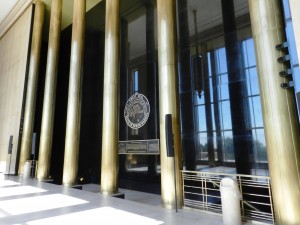 Linda Burton posting from Bismarck, North Dakota – “Over 80 percent of this capitol building is usable space,” the tour guide said. “As compared to Minnesota, say, where they can use only 29 percent. They have that big dome.” The guide has more numbers and comparisons; the North Dakota capitol cost $2 million to build in 1934, the Nebraska capitol, also a highrise, cost $11 million, she says. That’s $.46 per square foot vs $1.10. Frugality was a major consideration when building the North Dakota capitol; this is a state that simply doesn’t spend what it doesn’t have. After the old capitol burned in 1930, they sold 160 acres of land and used insurance money from the burned building to pay for the new capitol. Workers threatened a strike part-way
Linda Burton posting from Bismarck, North Dakota – “Over 80 percent of this capitol building is usable space,” the tour guide said. “As compared to Minnesota, say, where they can use only 29 percent. They have that big dome.” The guide has more numbers and comparisons; the North Dakota capitol cost $2 million to build in 1934, the Nebraska capitol, also a highrise, cost $11 million, she says. That’s $.46 per square foot vs $1.10. Frugality was a major consideration when building the North Dakota capitol; this is a state that simply doesn’t spend what it doesn’t have. After the old capitol burned in 1930, they sold 160 acres of land and used insurance money from the burned building to pay for the new capitol. Workers threatened a strike part-way 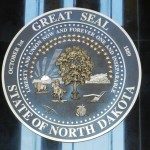 through; laborers asked for a raise from 30 cents an hour to 50. The governor called out the National Guard to protect the partially constructed building; workers were granted a 10 cent raise. Work continued, and the building was first occupied in January 1935. On time, and on budget. One thing I noticed right away; planning may have focused on frugal, and the outside may appear plain, but the building is impressive in its indoor elegance, and its streamlined efficiency.
through; laborers asked for a raise from 30 cents an hour to 50. The governor called out the National Guard to protect the partially constructed building; workers were granted a 10 cent raise. Work continued, and the building was first occupied in January 1935. On time, and on budget. One thing I noticed right away; planning may have focused on frugal, and the outside may appear plain, but the building is impressive in its indoor elegance, and its streamlined efficiency.
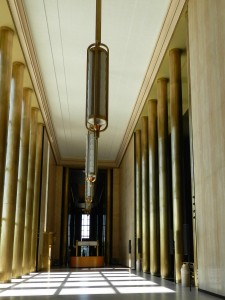 The tour started with a walk down Memorial Hall. The guide pointed out the simplicity of the Art Deco styling, the little details. I saw clean lines and open spaces, just like the landscape outside. Bronze columns soared to my right and my left, framing the state seal against a black granite wall; framing the long expanse of green lawn out front. The slender
The tour started with a walk down Memorial Hall. The guide pointed out the simplicity of the Art Deco styling, the little details. I saw clean lines and open spaces, just like the landscape outside. Bronze columns soared to my right and my left, framing the state seal against a black granite wall; framing the long expanse of green lawn out front. The slender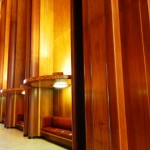 chandeliers above are 12 feet long and weigh a thousand pounds apiece; they represent a head of wheat in their design. Legislative Hall, the meeting place for Senators and Representatives, looks elegant and cozy too; the ceilings soar to 40 feet, but the wood paneled recessed seating areas provide an inviting spot to meet and talk. Usable space.
chandeliers above are 12 feet long and weigh a thousand pounds apiece; they represent a head of wheat in their design. Legislative Hall, the meeting place for Senators and Representatives, looks elegant and cozy too; the ceilings soar to 40 feet, but the wood paneled recessed seating areas provide an inviting spot to meet and talk. Usable space.
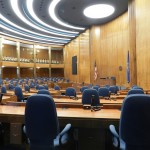 Next stop, the House chambers; serene in blue; 94 comfortably padded chairs for the two representatives from each of the 47 districts. “They meet for 80 days every other year,” the guide explained. “And their desks here are their offices; they have no other office space.” She pointed to the spacious visitor gallery
Next stop, the House chambers; serene in blue; 94 comfortably padded chairs for the two representatives from each of the 47 districts. “They meet for 80 days every other year,” the guide explained. “And their desks here are their offices; they have no other office space.” She pointed to the spacious visitor gallery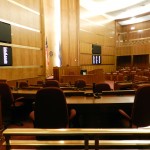 above, the lighting overhead. “It represents the stars and moon,” she said. The Senate chambers next; warm reds, with 47 seats; the walls are English oak, the desks American oak; lighting here represents sunrise or sunset. “Yes, everyone votes electronically,” she answered to my question. Efficiency.
above, the lighting overhead. “It represents the stars and moon,” she said. The Senate chambers next; warm reds, with 47 seats; the walls are English oak, the desks American oak; lighting here represents sunrise or sunset. “Yes, everyone votes electronically,” she answered to my question. Efficiency.
We topped off the tour in the observation tower; North Dakota stretched out as far as I could see; there’s the Missouri River shining blue just west of town. 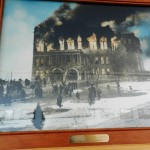 The walls are filled with history; pictures of the fire of 1883; the workers strike in 1933; the new capitol again and again, backdrop for so many happenings. “Here is my favorite,” the tour guide said, “and I was a part of this.” The year is 2007, it’s a Guinness Book of Records day; 8,962 North Dakotans making snow angels on the Capitol lawn. Streamlined!
The walls are filled with history; pictures of the fire of 1883; the workers strike in 1933; the new capitol again and again, backdrop for so many happenings. “Here is my favorite,” the tour guide said, “and I was a part of this.” The year is 2007, it’s a Guinness Book of Records day; 8,962 North Dakotans making snow angels on the Capitol lawn. Streamlined!
Ground floor to conclude. This spacious spot houses the Theodore Roosevelt Rough Rider Awards gallery, where portraits of North Dakotans who made major contributions to the state, or to their profession, are proudly displayed. Lawrence Welk was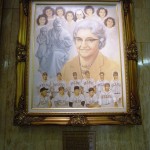 the first (1903-1992, Welk was born in the German-speaking community of Strasburg, North Dakota); 39 portraits hang here now; nominations are ongoing. I see actors, athletes, authors; educators, aviators, business leaders; military servants, public servants, philanthropists. I see Peggy Lee and Bobby Vee, Roger Maris and Eric Sevareid, Admiral William Owens and humanitarian Elizabeth Bodine (1898-1986), who was Mother of the Year in North Dakota, and the United States, in 1968. Elegant.
the first (1903-1992, Welk was born in the German-speaking community of Strasburg, North Dakota); 39 portraits hang here now; nominations are ongoing. I see actors, athletes, authors; educators, aviators, business leaders; military servants, public servants, philanthropists. I see Peggy Lee and Bobby Vee, Roger Maris and Eric Sevareid, Admiral William Owens and humanitarian Elizabeth Bodine (1898-1986), who was Mother of the Year in North Dakota, and the United States, in 1968. Elegant.
About the North Dakota State Capitol http://www.nd.gov/content.htm?parentCatID=75&id=State%20Capital
 Notes about the two other high-rise capitols:
Notes about the two other high-rise capitols:
From Nebraska’s web site: Capitol construction started in 1922, was completed in 1932. There are 15 floors above ground; the building is 400 feet tall; it cost $9.8 million in 1932 dollars. http://capitol.org/building
From Louisiana’s web site: The Louisiana State Capitol was completed in March 1932 in 14 months and stands on a 27-acre tract; the building is 450 feet high with 34 floors. The cost to complete the building was $5 million. http://www.crt.louisiana.gov/tourism/capitol/
